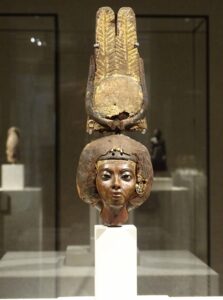Queen Tiye, the Great Royal Wife of Pharaoh Amenhotep III and the mother of Pharaoh Akhenaten, was one of the most powerful figures in ancient Egyptian history. This exquisitely carved head serves as a vivid testament to her authority and influence within the Egyptian court during the 18th Dynasty. The sharp details of her face and crown not only reflect her regal status but also embody the significant roles she played during a transformative period in Egyptian history.
Queen Tiye: Political Power and Influence
The sculpture depicts the queen’s face with clear, powerful features, especially her resolute and wise expression. Crafted from dark wood and adorned with gold and lapis lazuli accents on her crown, the details on Tiye’s headpiece emphasize her wealth and power within the Egyptian elite. The high, intricately designed crown is not only a symbol of her nobility but also a clear indication of her significant influence in the royal hierarchy of Pharaoh Amenhotep III’s reign.
Tiye was more than just the wife of a Pharaoh; she was a powerful advisor, often playing a pivotal role in key political decisions. Evidence suggests she was deeply involved in diplomacy, negotiating international treaties and forging alliances that helped maintain peace and prosperity for Egypt during her husband’s reign. She likely had a strong voice in foreign policy and court affairs, demonstrating the extent of her influence in both domestic and international matters.

A Symbol of Prosperity and Active Involvement
Queen Tiye’s influence extended beyond politics. She was actively engaged in the cultural and religious life of her time. Tiye was one of the first members of the royal family to be worshiped as a goddess, which highlights the respect she commanded from both the people and the aristocracy. Archaeological evidence suggests that she maintained close relations with foreign leaders, strengthening Egypt’s position on the international stage through diplomatic and marital alliances.
In addition to supporting her husband in governance, Tiye was also the mother of Akhenaten, the Pharaoh famous for introducing the worship of Aten, the Sun Disc. While Akhenaten’s religious reforms were controversial, it’s undeniable that Tiye’s role in solidifying her son’s power helped shape a major turning point in Egypt’s history, setting the stage for the dramatic religious and political changes that would follow.

Leaving a Mark on History
The head sculpture of Queen Tiye, with its intricate details from the materials to her facial features, has left a lasting impression not only in Egyptian sculpture but also in our understanding of the civilization itself. This is not merely a work of art; it is a testimony to Tiye’s strength, intelligence, and profound influence in her society.
Queen Tiye remains one of the most powerful women in history, and through this sculpture, we can appreciate the immense power she held — a symbol of prosperity, wisdom, and strong leadership during a period of great change in ancient Egypt.
